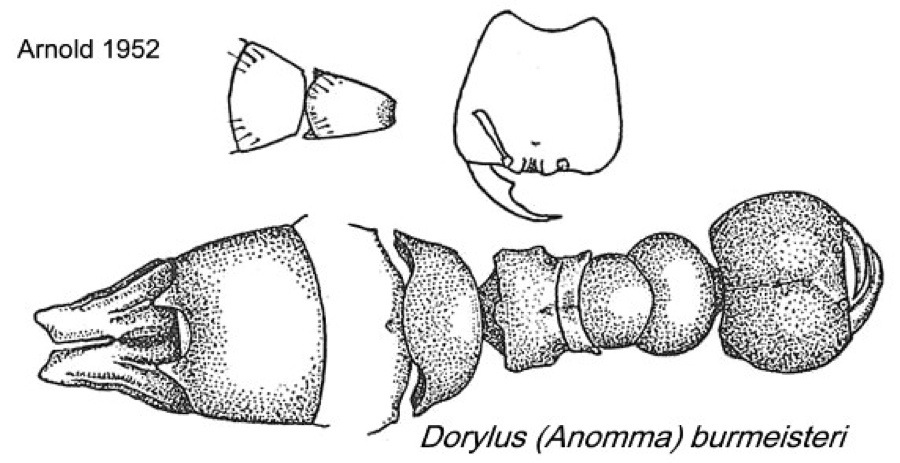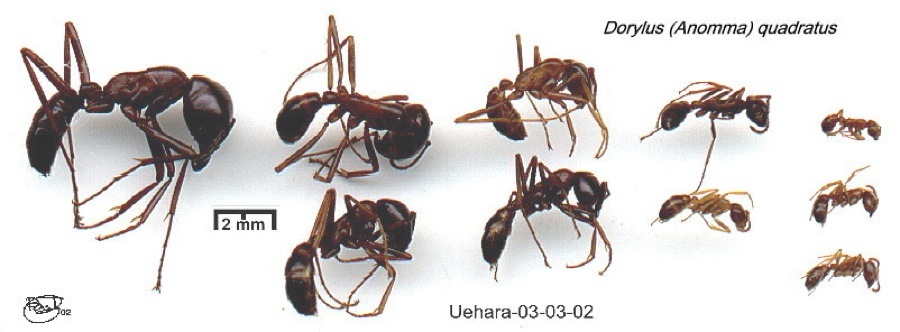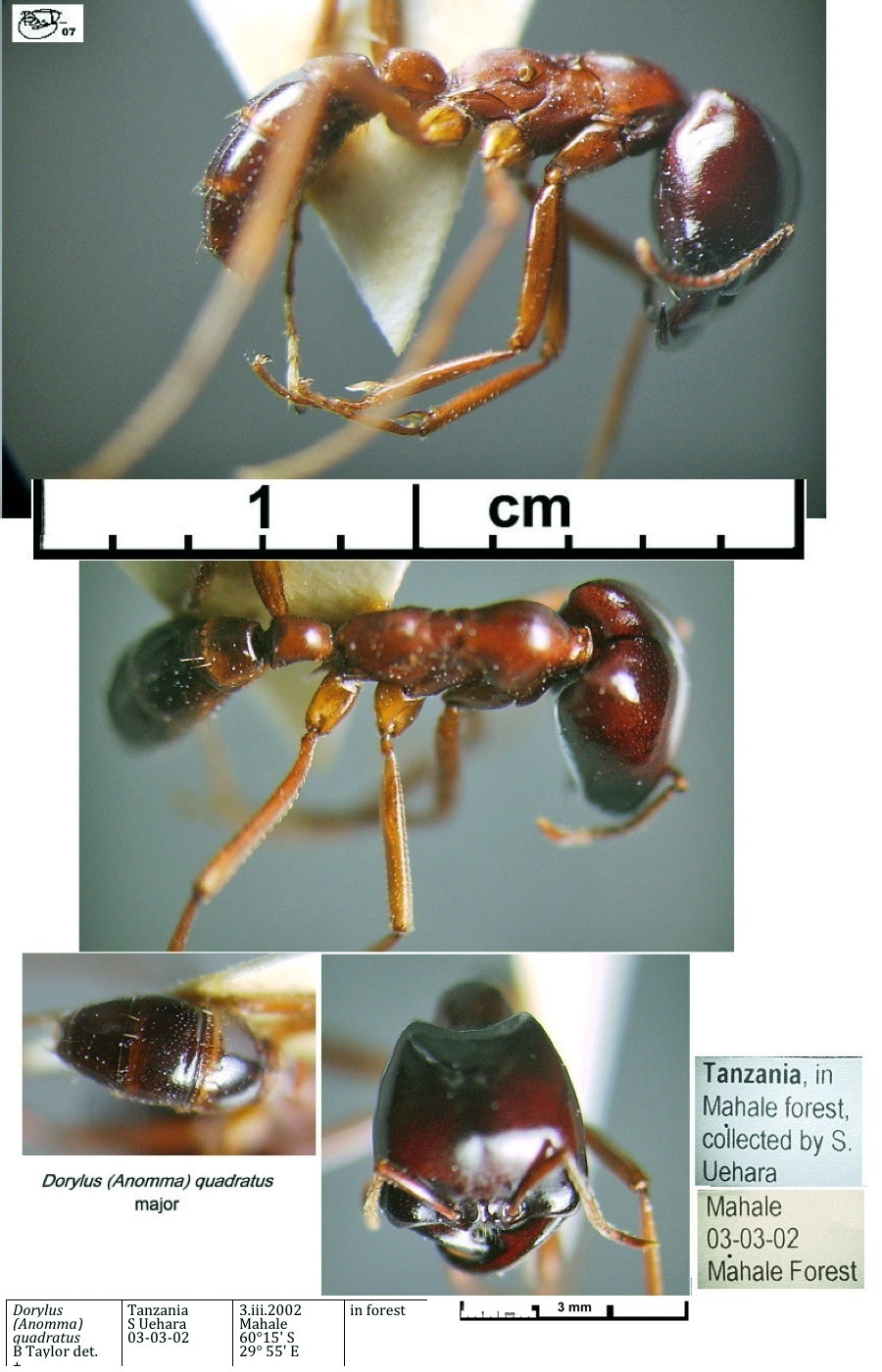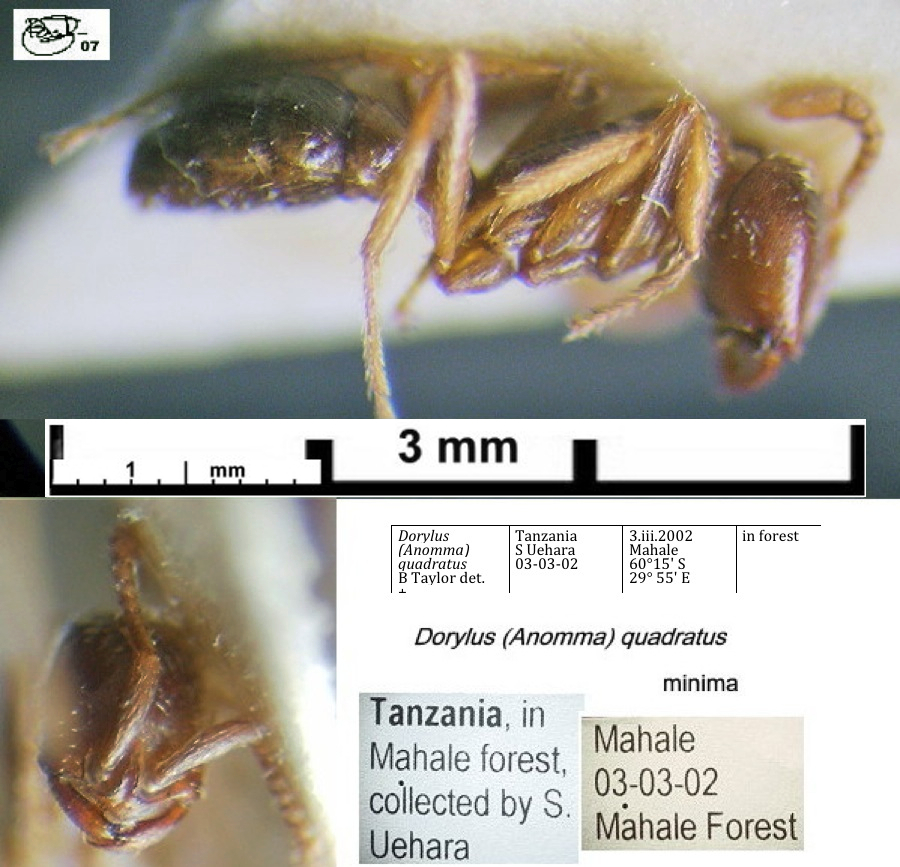Dorylus (Anomma) quadratus Santschi - new status
  Type locality Tanzania
(Dorylus (Anomma) Gerstaeckeri Em. stirps quadratus
n.st.,
Santschi, 1914a: 230, major; Raignier & van Boven, 1955, major)
collected at Manou, by Viehmeyer - see worker morphs page (note there
are two workers, a media 3 and a minima, labelled from Manow) Type locality Tanzania
(Dorylus (Anomma) Gerstaeckeri Em. stirps quadratus
n.st.,
Santschi, 1914a: 230, major; Raignier & van Boven, 1955, major)
collected at Manou, by Viehmeyer - see worker morphs page (note there
are two workers, a media 3 and a minima, labelled from Manow)  . .
|
Santschi's (1914a) description is at  . .
In his note, Santschi (1914a) described quadratus as known from a single major worker (using the sign for that), TL 10 mm, from Tanzania (German East Africa, at Manow) as dark
red, differing from the type (Dorylus (Anomma)
gribodoi as gerstaeckeri) by the denser and stronger
puncturation of the petiole; the head straighter to the front; pilosity
of petiole and gaster more abundant than on burmeisteri.
As noted above, however, the surviving worker specimens, as imaged by
the Antweb team, are what I judge to be a media 3 and a minima.
|
 Arnold (1952)
commented on a queen and workers taken
together at Kinganop, Kenya, by Mrs V Fey. I have adapted his
illustration (right) (see also Arnold (1952)
commented on a queen and workers taken
together at Kinganop, Kenya, by Mrs V Fey. I have adapted his
illustration (right) (see also  . Arnold titled his paper as a note on "a
Female Dorylus (Anomma) Nigricans Ill. taken with workers" and labelled
the illustration "Anomma nigricans var. molesta" (now molestus),
arguing that, according to the key produced by Santschi (1912), because
the posterior angles of the petiole are prolonged backwards, they must
be molestus. My interpretation (2007) is that they are quadratus. The head shape of the major in
Arnold's picture and the female match the illustrations I use here; the
latter being that of Raignier & van Boven. Essentially, I feel the
same way about the specimens described by van Boven (1972) as molestum
(molestus) [see . Arnold titled his paper as a note on "a
Female Dorylus (Anomma) Nigricans Ill. taken with workers" and labelled
the illustration "Anomma nigricans var. molesta" (now molestus),
arguing that, according to the key produced by Santschi (1912), because
the posterior angles of the petiole are prolonged backwards, they must
be molestus. My interpretation (2007) is that they are quadratus. The head shape of the major in
Arnold's picture and the female match the illustrations I use here; the
latter being that of Raignier & van Boven. Essentially, I feel the
same way about the specimens described by van Boven (1972) as molestum
(molestus) [see  ],
which to me are not molestus
but are quadratus. ],
which to me are not molestus
but are quadratus.
|
Note Schoning et
al. (2008: 49) recognized quadratus
as clearly distinct from D. gribodoi but place it as a junior
synonym of Dorylus
(Anomma) kohli, having sighted the types of both. They gave no
other information. If my diagnosis of the latter from Guinea is correct
then there are clear but subtle differences between the two species.
|
Oxford University Museum
specimens
Dorylus (Anomma) quadratus
B Taylor det.
|
Tanzania
S Uehara
03-03-02
|
3.iii.2002
Mahale
60°15' S
29° 55' E
|
In forest
|
4
|
 |
Dorylus (Anomma) quadratus
B Taylor det. |
Tanzania
S Uehara
III-57
|
3.iii.2002
Mahale
60°15' S
29° 55' E
|
forest |
2
|
|
Dorylus (Anomma) quadratus
B Taylor det.
|
Tanzania
S Uehara
III-58
|
3.iii.2002
Mahale
60°15' S
29° 55' E
|
jforest
|
2
|

|
Dorylus (Anomma) quadratus
B Taylor det. |
Ethiopia
Nuru Adgaba
|
2011
Bonga
07°23'N
36°14'E
|
Hand collected, surface foraging
1650 m
|
13
|

|
|
 Polymorphism Polymorphism
The photomontages are of specimens from Tanzania,
collected by the Chimpanzee study project led by the late Professor
Shigeo Uehara. The various morphs are shown in detail on Dorylus (Anomma) quadratus
morphs page. A full range of morphs from Ethiopia can be seen on the Dorylus (Anomma)
quadratus
Ethiopia morphs page (the minima morph at least differs slightly).
|
 Full
new description Uehara
03/03/02 Full
new description Uehara
03/03/02
Major. TL 10.05 HW 2.75 HL
2.75 HD 1.85 CI 100 SL 1.5 SI 55 AL 3.0 PW 0.9 PetL 0.8 GL 3.5 MFL 2.5
Overall appearance - shiny but matt rather than polished generally
orange chestnut, darker on anterior of head and apical gaster.
Head - widest at about 1/8 from anterior, posterior perhaps 1/5
narrower; sides smoothly convex, curve steepening in hind 1/3;
posterior margin shallow scallop, with flat central area, angles quite
sharp; fine spiculation visible evenly all over face, sparse minute
hair pits; median line almost invisible; clypeus sinuous, with strong
down turned median hair and other long fringing hairs; mandible
moderately long and stout, quite large subapical tooth and denticles,
basal tooth a large oblique triangle; scape out curved, stout,
broadening from base to apex, matte; funiculus with basal two segments
fairly slender, rest stout not much longer than wide very bristly;
segment 10 only 1.5 X 9; head with very bulbous dorsum, venter
shallowly convex; slight extension of posterior corners; very minute
sparse pilosity on occiput.
Alitrunk - profile shallowly domed, with shallow step down to distinct
but not pronounced "saddle"; spiracle vertically ovoid and strongly
raised anterior so facing rearward; deep groove subtending lower
margin; propodeum rising noticeably from saddle, then steepening curve
to sub-vertical declivity; metapleural gland upper longer than lower
and slightly upturned; sculpturation all over fine spiculation,
coarsening rearward and downwards; hairs minute sparse fine on
shoulders.
Petiole - in profile moderately long, with all edges rounded; distinct
posteroventral protrusion; in dorsal view straight sided but doubling
in width from front to back; strong posteroventral processes; spiracle
small and strongly raised; subpetiolar process quite large narrow
triangle rising from flange full length of venter; sculpturation as
alitrunk; hairs - none dorsally, several quite coarse hairs ventrally.
Gaster - sculpturation of basal segment as petiole, rest near smooth
and shiny; moderately waisted; coarse hairs on dorsum of 1, fringes of
others and ventrally.
Legs - coxae short and broad based; femora moderately wide, matte with
micropilosity; tibiae relatively short, with fine and quite sparse
bristles; tarsi relatively short, moderate claws.
|
 Minima
morph Minima
morph
Head shiny, colour dark chestnut; dorsum with very fine decumbent
pilosity; funiculus slender with fine pilosity.
|
|